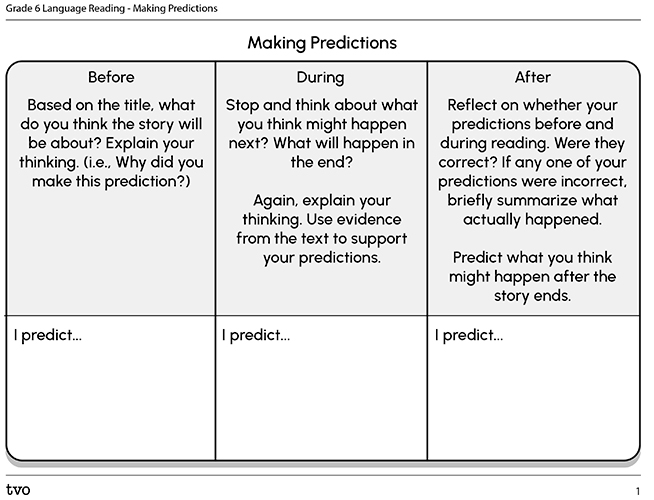Minds On
What is a prediction?

Take a moment to consider:
- What is a prediction?
- When can we make predictions about a text?
- What information do we need to make predictions about a text?
Record your ideas using a method of your choice.
When you are ready, press the ‘Answer’ button to reveal the definition of prediction.
“I think… will happen next because…”
A prediction involves making a guess about what you think might happen in the future.
As readers, we can use information from a text as well as our background knowledge to think ahead or predict what will happen next. Making predictions helps us to monitor our understanding before, during, and after reading.
Action
Make a prediction
We can make predictions about a text before, during, and after reading.
Here are examples of sentence starters we can use to make predictions:
- I think… will happen because…
- I predict… because…
- I wonder if… because…
- I know… so I think… will happen next.
- At first I thought… but now I think… because…
It's important to use information (words, pictures or illustrations, and/or other text features) from the text as evidence to support the predictions we make. This helps us to make more reasonable predictions and become more actively engaged in the things we read!
What is the story between the lines… beyond the lines?
In addition to predictions, we can also make inferences about a text. Inferring means you must go beyond the information that the author has explicitly provided you with. You use information from the text and what you know (i.e., background knowledge) to draw conclusions about something in the text.
Examine the following sentences. Can you pick out the inference?
I noticed that Sola was not in our virtual class this morning. Come to think of it, yesterday she mentioned that she had a toothache. She must have gone to the dentist!
Press ‘Hint’ to reveal the inference.
Here are examples of sentence starters we can use to make inferences:
- This makes me think… because…
- I can infer… because…
- The author didn’t say this, but I think… because…
- This clue in the book makes me think… because
- My conclusion is… because…
Student Success
Think-Pair-Share
- Think: What is the purpose and value of making predictions when reading? What is the purpose and value of making inferences when reading?
- Pair: Record your thinking using a method of your choice. If possible, discuss your ideas with a partner.
- Share: If possible, share your ideas with the same partner or a new partner.
Note to teachers: See your teacher guide for collaboration tools, ideas and suggestions.
Making predictions

Examine the following four passages and predictions for each passage.
Passage 1
Alexandra and Kevin went to the grocery store to buy everything they would need for the potluck dinner party they are hosting tonight. The last time they did this, the dinner party ran quite smoothly. Someone brought the bread as they’d promised, and someone else brought a fruit platter as they promised. This time they were determined to have another wonderful evening. Kevin checked the grocery list, and he felt like he was forgetting something, but he couldn’t figure out what it was.
- Prediction: Kevin forgot to send out the invitations to the dinner party.
- What can you infer?
Passage 2
Farhan and Olivia sat in the library studying their textbooks. They had already been there for a couple of hours! The library would close soon, but there was so much left to study. They only had one night to review everything.
- Prediction: Farhan and Olivia will take a test tomorrow.
- What can you infer?
Passage 3

Shawn was feeling excited. Tonight was going to be the first time he would perform piano for his family and friends. He has been practicing for months! He's hoping that they are just as excited as he is!
- Prediction: Shawn's family and friends loved his performance.
- What can you infer?
Passage 4
Lilly and Xenia decided to go to the zoo over the weekend. They saw so many different animals including a Western lowland gorilla, a blue and yellow macaw, and a Sumatran orangutan! Lilly was really hoping to see the kangaroos, but they couldn't locate the Australasian Pavillion. Xenia spotted someone who looked like a volunteer at the zoo. She decided to walk over and ask for directions.
- Prediction: The volunteer at the zoo helped Xenia and Lilly to find the kangaroos.
- What can you infer?
Sort the following predictions based on whether or not you believe they are reasonable.
Then, make an inference based on a) the information in the text and b) your background knowledge. What conclusions can you draw from the information in each passage?
You can use the following fillable and printable Making Predictions and Inferences chart to sort the predictions. You can also use your notebook or another method of your choice.
| Prediction Statement | The prediction is reasonable and here’s why | The prediction is unreasonable and here’s why | What I can infer: (Using information from the passage and my background knowledge.) |
|---|---|---|---|
| Passage 1: Kevin forgot to send out the invitations to the dinner party. | |||
| Passage 2: Farhan and Olivia will take a test tomorrow. | |||
| Passage 3: Shawn's family and friends loved his performance. | |||
| Passage 4: The volunteer at the zoo helped Xenia and Lilly to find the kangaroos. |
Press the ‘Activity’ button to access Making Predictions and Inferences.
Consolidation
Make your own predictions

Select a book or audiobook of your choice. Then, record your ideas to the following questions using the fillable and printable Making Predictions template. You can also record your ideas in your notebook or use another method of your choice.
Part 1: Record the title of the story
- Based on the title, what do you think the story will be about?
- Explain your thinking. For example, why did you make this prediction?
Part 2: Now read and/or listen to the first half of the story
- Stop and think about what you think might happen next. What will happen in the end?
- Again, explain your thinking. Use evidence from the text to support your predictions.
Part 3: Now read and/or listen to the rest of the story
- Reflect on your predictions before and during reading. Were they correct? If any one of your predictions were incorrect, briefly summarize what actually happened.
- Predict what you think might happen after the story ends.
Let’s reflect

Use the follow questions to reflect on your learning. Record your responses using a method of your choice. You can type, write, use speech-to-text, or create an audio recording.
- Why do readers make predictions? How does this strategy help you as a reader?
- Does it matter if your predictions are correct? Why or why not?
- Suppose you had to explain how to make predictions to someone. How would you describe the strategy? What text features could they use to make predictions?
When you review your notes on this learning activity later, reflect on whether you would select a different description based on your further review of the material in this learning activity.
Reflection
As you read the following descriptions, select the one that best describes your current understanding of the learning in this activity. Press the corresponding button once you have made your choice.
I feel...
Now, expand on your ideas by recording your thoughts using a voice recorder, speech-to-text, or writing tool.
